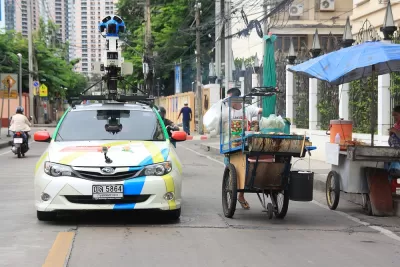At this time of year, many prospective graduate students are asking themselves if they should apply to planning programs. This is a good question. Planning is a diverse field and it can be hard to figure out if it will be the right fit.

At this time of year, many prospective graduate students are asking themselves if they should apply to planning programs. This is a good question. Planning is a diverse field and it can be hard to figure out if it will be the right fit.
Some years ago a committee of the Association of Collegiate Schools of Planning, let by Professor Dowell Myers, developed the “anchor points for planning’s identification.” This paper identifies six core themes in planning, which parallel many of the reasons people choose planning as a career. They provide a good starting point for prospective students. They include:
- Improving human settlements. This involves understanding and influencing physical, social, and economic dimensions with an emphasis on serving people’s needs. For many planning can help create better places in the here and now—more delightful and supportive, more just and efficient.
- Making connections. Planners can link sectors like transportation and housing, or public and private “enterprises.” This is part of what makes planning so important and difficult—as generalists with a specialty planners understand the broad picture while also specializing in some topical areas. We work at multiple scales, on multiple issues, with multiple publics. In a world calling for more work across disciplines, planning has an edge.
- Dealing with the future and “pathways of change.” We are in difficult times with a great many changes likely in the next 50 years—ecological, demographic, economic, in terms or city growth and shrinkage. Planning’s focus on the long-term provides a powerful lens for assessing current actions. Planners have decades of experience of getting predictions right and wrong; of developing plausible scenarios for possible futures. This is an area for growth.
- Identifying diverse needs and how they play out in human settlements. This is a fundamentally ethical issue. Planners care about who gets what in material terms. But also how to support diverse sets of values and meanings in a way that fair to all in the long term. Planning’s ethical commitment to social justice is the reason many come to the field.
- Engaging “open participation in decision making.” This is about finding appropriate ways to incorporate diverse perspectives in often complex decision making using a variety of techniques that respect people’s time and values. Such processes are not simple and raise large ethical questions that can fill a career.
- Linking knowledge to action. The topic of implementation is front and center for planning. Planning uses diverse tools to get things done—building things, financing improvements, regulating change, incentivizing innovations, educating key stakeholders, negotiating agreements, and so on. This big tool kit can attract many to planning.
These are all important reasons to plan—they manage change in complicated situations at multiple scales over time. This can be portrayed as being too fragmented to some, but those who choose planning do so because they seed the benefits of a comprehensive, plural, ethical, future-oriented, humane field.
From 2007 through December 2012 I wrote monthly blogs. For the last two years as a program director I have been so busy dealing with my own students it has been hard to read beyond them—so I’ve only blogged a few times. But now I really am back to blogging and will start again with my monthly blogs focused on the intersections between education, planning, and urbanization.

Study: Maui’s Plan to Convert Vacation Rentals to Long-Term Housing Could Cause Nearly $1 Billion Economic Loss
The plan would reduce visitor accommodation by 25,% resulting in 1,900 jobs lost.

North Texas Transit Leaders Tout Benefits of TOD for Growing Region
At a summit focused on transit-oriented development, policymakers discussed how North Texas’ expanded light rail system can serve as a tool for economic growth.

Using Old Oil and Gas Wells for Green Energy Storage
Penn State researchers have found that repurposing abandoned oil and gas wells for geothermal-assisted compressed-air energy storage can boost efficiency, reduce environmental risks, and support clean energy and job transitions.

Private Donations Propel Early Restoration of Palisades Playground
Los Angeles has secured over $1.3 million in private funding to restore the Pacific Palisades playground months ahead of schedule, creating a modern, accessible space that supports community healing after recent wildfires.

From Blight to Benefit: Early Results From California’s Equitable Cleanup Program
The Equitable Community Revitalization Grant (ECRG) program is reshaping brownfield redevelopment by prioritizing projects in low-income and environmental justice communities, emphasizing equity, transparency, and community benefits.

Planting Relief: Tackling Las Vegas Heat One Tree at a Time
Nevada Plants, a Las Vegas-based nonprofit, is combating the city’s extreme urban heat by giving away trees to residents in underserved neighborhoods, promoting shade, sustainability, and community health.
Urban Design for Planners 1: Software Tools
This six-course series explores essential urban design concepts using open source software and equips planners with the tools they need to participate fully in the urban design process.
Planning for Universal Design
Learn the tools for implementing Universal Design in planning regulations.
Ascent Environmental
Borough of Carlisle
Institute for Housing and Urban Development Studies (IHS)
City of Grandview
Harvard GSD Executive Education
Toledo-Lucas County Plan Commissions
Salt Lake City
NYU Wagner Graduate School of Public Service






























